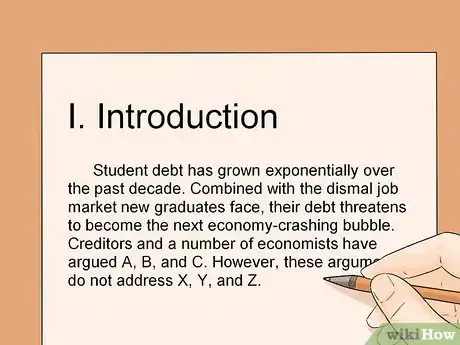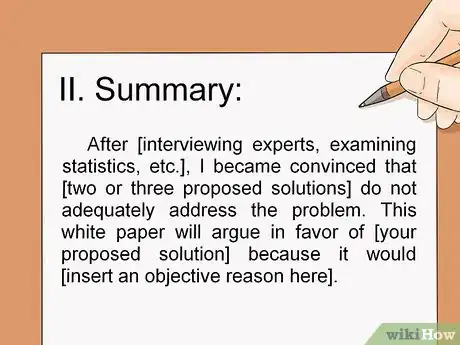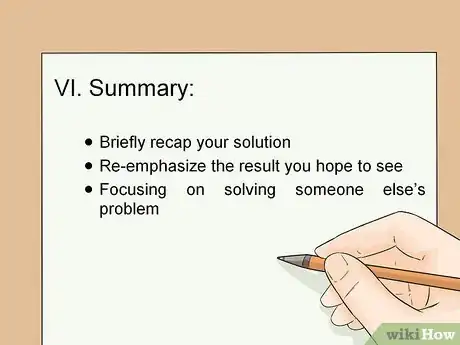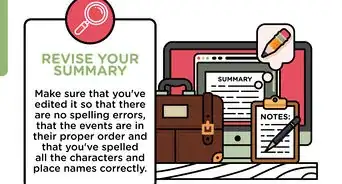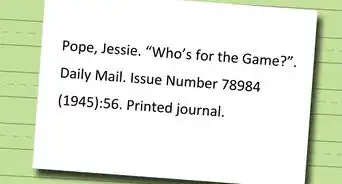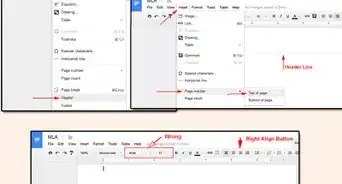This article was co-authored by wikiHow Staff. Our trained team of editors and researchers validate articles for accuracy and comprehensiveness. wikiHow's Content Management Team carefully monitors the work from our editorial staff to ensure that each article is backed by trusted research and meets our high quality standards.
There are 8 references cited in this article, which can be found at the bottom of the page.
wikiHow marks an article as reader-approved once it receives enough positive feedback. This article received 33 testimonials and 96% of readers who voted found it helpful, earning it our reader-approved status.
This article has been viewed 742,075 times.
Learn more...
A white paper is a one-to five-page document that describes a given problem and proposes a specific solution to the problem. It's commonly used in government and corporate settings. A typical white paper might list ways to meet a client's marketing needs, suggest the use of a certain product for a technical process, or identify ways to tackle municipal problems. To write a successful white paper, you must know your audience, state your problem clearly, and make a convincing and engaging argument of how to solve it.[1]
Steps
Engaging Your Audience
-
1Determine your audience. Typically, you won't know your audience personally. However, you should identify as many factors as possible, such as professional needs, educational backgrounds, and job title(s). These aspects will determine how to form your argument. Mold your proposal to be relatable to your audience based on these factors.[2]
- For example, if your topic is community gardens, appeal to your readers as property owners and parents, as well as community decision-makers. They'll be interested in learning about the impact of gardening and local food on their property values, their children's health, and their children's education.
-
2Figure out their level of expertise. This will establish how simple or complex your paper should be. If your audience's expertise matches or is close to your own, you could include technical jargon. For a general audience, however, keep the paper as jargon-free as possible. If you must include specific terminology, use it sparingly and explain it. For example:[3]
- If you're writing a white paper for an engineer, you should include lots of technical details and be lengthy in your descriptions.
- If you're writing for a government official, focus on policy-related implications.
- If you're writing for a corporate audience, focus on cost-effectiveness and growth potential.
Advertisement -
3Choose a catchy title. Make it attention-grabbing but not over-the-top. Mention or allude to your problem. Some titles incorporate the words “white paper,” but this isn't mandatory. Tailor the language to a general audience. Some good examples include:
- Closing the School-to-Prison Pipeline with Art
- Safer Cities through Community Gardens: A White Paper
-
4Get right to the point. Assume your reader has a very busy life. Explain exactly what your white paper is about without adding unnecessary padding. Make your first couple of sentences engaging enough to grab their attention.
-
5Write the introduction. Acknowledge your audience and how you intend them to use the paper. Summarize the present order of things and why it's a problem. Briefly discuss the arguments of your opposition and why you're proposing something different. For example, if you were writing on student debt, you might say:[4]
- Student debt has grown exponentially over the past decade. Combined with the dismal job market new graduates face, their debt threatens to become the next economy-crashing bubble. Creditors and a number of economists have argued A, B, and C. However, these arguments do not address X, Y, and Z.
-
6Summarize your solution. Briefly introduce the methodology you'll use in your analysis. Detail possible solutions you have rejected and why you rejected them. Explain why your audience should accept your proposed solution. For example, your solution to the student debt bubble could be:[5]
- After [interviewing experts, examining statistics, etc.], I became convinced that [two or three proposed solutions] do not adequately address the problem. This white paper will argue in favor of [your proposed solution] because it would [insert an objective reason here].
Discussing the Problem
-
1Identify the problem. For this step, you'll have to know your reader's needs. Focus on the challenges that you propose to solve. This should be something you can phrase in a few words.[6]
- Examples of problems include "decreasing sales," "slow network speeds," or "management-employee conflicts."
-
2Analyze the problem. This helps to make your argument credible in the mind of your reader. Describe the problem you identified in greater depth. Give details as to how you concluded this is a problem. Use clear, precise terms. Your analysis should last no more than a paragraph.
-
3Provide a historical overview. Historical overviews help to explain how the problem in question became a problem. If possible, you could also discuss how your problem was once a solution. Use specific figures, dates, and names to explain this progression.
- For example, a white paper on addressing climate change might discuss how hydrofluorocarbons (HFCs) were once believed to be a safe replacement for chlorofluorocarbons (CFCs), which had produced a hole in the ozone layer. However, we now know that HFCs are actually dangerous greenhouse gases.
-
4Use visual aids. Include charts, graphs, or diagrams to help to back up your white paper's argument. They can also win an audience's attention. Some white papers integrate visual aids into the text. Others place them in an appendix at the end. Ask your employer which method they prefer.[7]
-
5Provide additional background. Analyze the data and figures you present. Detail how you arrived at your conclusions. Make sure you've examined all the facts so that there are no holes in your findings. You should aim to produce findings that can be reproduced through the analysis you conducted.
Arguing Your Solution
-
1Describe your proposed solution(s). Adopt a step-by-step approach that clarifies exactly how you intend your idea to be implemented. Divide your content into digestible parts, such as bulleted lists or individual paragraphs with their own bold headings. This will help your audience to read and understand your argument.
- If you're writing your paper within a corporate context, avoid mentioning your company's product at this point. Focus instead on what to expect in a solution.
-
2Justify your solution. Use hard evidence, such as trade journals, government publications, and the data and figures in your research, to explain why your solution is the best course of action to take. Weigh your argument against other proposed solutions. Acknowledge the usefulness of opposing solutions while emphasizing why they fall short of solving the problem.[8]
-
3Close with a summary. Include a review of the problem at hand. Briefly recap your solution. Re-emphasize the result you hope to see. If you choose to slip in a plug for your product or company, keep it relevant and subtle. Remember you're focusing on solving someone else's problem, as opposed to promoting a product or service for personal gain.[9]
Community Q&A
-
QuestionOver time, should white papers be revised to reflect current thought or should they just be retired when either the issue or the information is no longer current?
 Community AnswerGood question! Unfortunately, there don't seem to be any clear answers. I would definitely err on the side of revision. However, a copy of the old white paper should be kept in a database for historical overviews in future documents.
Community AnswerGood question! Unfortunately, there don't seem to be any clear answers. I would definitely err on the side of revision. However, a copy of the old white paper should be kept in a database for historical overviews in future documents. -
QuestionDo you indent a white paper?
 Community AnswerAlthough Purdue OWL doesn't specify whether or not to indent, the white papers available online do not indent. Unless your employer specifies otherwise, each paragraph is single spaced with a double space between paragraphs. Paras are also marked by numbered and bulleted lists.
Community AnswerAlthough Purdue OWL doesn't specify whether or not to indent, the white papers available online do not indent. Unless your employer specifies otherwise, each paragraph is single spaced with a double space between paragraphs. Paras are also marked by numbered and bulleted lists. -
QuestionShould a white paper include costs of implementing solutions?
 Community AnswerIf you are selling a product or service in a competitive environment, then cost will be a decisive factor. If cost is a selling point it is necessary to highlight it.The cost benefit can be introduced in a comparative table or other statistical formats.
Community AnswerIf you are selling a product or service in a competitive environment, then cost will be a decisive factor. If cost is a selling point it is necessary to highlight it.The cost benefit can be introduced in a comparative table or other statistical formats.
References
- ↑ https://libguides.uml.edu/whitepaper_style
- ↑ https://owl.purdue.edu/owl/subject_specific_writing/professional_technical_writing/white_papers/index.html
- ↑ https://writingcenter.uagc.edu/writing-white-paper
- ↑ https://writingcenter.uagc.edu/writing-white-paper
- ↑ https://owl.purdue.edu/owl/subject_specific_writing/professional_technical_writing/white_papers/index.html
- ↑ https://owl.purdue.edu/owl/subject_specific_writing/professional_technical_writing/white_papers/index.html
- ↑ https://writingcenter.uagc.edu/writing-white-paper
- ↑ https://owl.purdue.edu/owl/subject_specific_writing/professional_technical_writing/white_papers/organization_and_other_tips.html
- ↑ https://owl.purdue.edu/owl/subject_specific_writing/professional_technical_writing/white_papers/organization_and_other_tips.html
About This Article
To write a white paper, start with an introduction summarizing a problem you’re dealing with, then how you propose to solve that problem. Detail possible solutions you have rejected and why you rejected them. Next, describe the problem you identified in greater depth and provide a historical overview of how it became a problem, then describe your solution in more detail. Use charts, graphs, and diagrams to back up your points and to make your paper easier to read. For advice on tailoring your paper to your audience, read on!




